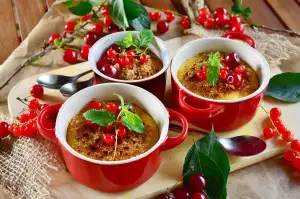Spice up your culinary repertoire with our mouthwatering lamb curry recipe

Lamb curry is a flavorful and aromatic dish that has been enjoyed for centuries. It is a staple in many cuisines around the world, including Indian, Pakistani, and Middle Eastern. The rich and tender meat combined with a blend of spices creates a dish that is both comforting and exotic. Whether you are a seasoned cook or just starting out in the kitchen, lamb curry is sure to impress your taste buds and elevate your culinary skills. So get ready to embark on a journey of flavors as we explore the history, ingredients, and recipe for this mouthwatering dish.
History and Origins of Lamb Curry
Lamb curry has a rich history that dates back centuries. It is believed to have originated in the Indian subcontinent, where it quickly became a staple dish in various regional cuisines. The use of lamb in curries can be traced back to the Mughal era, when the rulers introduced Persian and Central Asian influences to Indian cuisine. Over time, different regions developed their own unique styles of lamb curry, incorporating local spices and cooking techniques. Today, lamb curry is enjoyed worldwide for its bold flavors and aromatic spices.
Ingredients Required for Lamb Curry
To make a delicious lamb curry, you will need the following ingredients:
- 500 grams of boneless lamb, cut into cubes
- 2 onions, finely chopped
- 3 cloves of garlic, minced
- 1-inch piece of ginger, grated
- 2 tomatoes, pureed
- 2 tablespoons of vegetable oil
- 1 teaspoon of cumin seeds
- 1 teaspoon of coriander powder
- 1/2 teaspoon of turmeric powder
- 1/2 teaspoon of red chili powder (adjust according to your spice preference)
- Salt to taste
- Fresh coriander leaves for garnish
These ingredients will give your lamb curry a rich and flavorful taste. Make sure to gather them all before starting the cooking process.
Step-by-Step Recipe for Lamb Curry
1. Heat oil in a large pan and add chopped onions, garlic, and ginger. Sauté until golden brown.
2. Add lamb pieces to the pan and cook until browned on all sides.
3. Sprinkle curry powder, cumin, coriander, turmeric, and chili powder over the lamb. Stir well to coat the meat evenly.
4. Pour in coconut milk and tomato puree. Bring to a simmer and let it cook for 1 hour or until the lamb is tender.
5. In a separate pan, heat ghee and add cinnamon sticks, cardamom pods, cloves, and bay leaves. Fry for a minute to release their flavors.
6. Add this mixture to the lamb curry along with salt and sugar. Stir well and let it simmer for another 10 minutes.
7. Garnish with fresh cilantro leaves before serving with rice or naan bread.
8. Enjoy your flavorful and aromatic homemade lamb curry!
Tips and Tricks for Perfect Lamb Curry
To achieve the perfect lamb curry, here are some tips and tricks to keep in mind. Firstly, marinating the lamb overnight will enhance its flavor and tenderness. Secondly, use a combination of spices like cumin, coriander, turmeric, and garam masala for a well-balanced taste. Thirdly, slow-cooking the curry on low heat allows the flavors to meld together beautifully. Additionally, adding a splash of coconut milk or yogurt can add creaminess to the dish. Lastly, don't forget to taste and adjust the seasoning before serving to ensure it's just right. These tips will surely elevate your lamb curry game!
Variations and Adaptations of Lamb Curry
Lamb curry is a versatile dish that can be customized to suit different tastes and dietary preferences. Here are some variations and adaptations you can try:
1. Regional Flavors: Explore the diverse regional cuisines that offer unique twists to lamb curry. From the fiery flavors of South Indian lamb curry to the aromatic spices of Kashmiri Rogan Josh, each region has its own signature style.
2. Vegetarian Options: If you prefer a meatless version, you can substitute lamb with vegetables like potatoes, cauliflower, or chickpeas. This will create a hearty and flavorful vegetarian curry.
3. Spice Level: Adjust the spice level according to your preference. Add more chili powder or fresh chilies for a spicier kick, or reduce it for a milder flavor.
4. Creamy Variation: For a creamy twist, add coconut milk or yogurt to your lamb curry. This will impart a rich and velvety texture to the dish.
5. Slow Cooker Method: To save time and effort, consider using a slow cooker for your lamb curry. Simply combine all the ingredients in the slow cooker and let it cook on low heat for several hours until the meat is tender and infused with flavors.
6. Fusion Flavors: Experiment with fusion flavors by adding ingredients like lemongrass, ginger, or even soy sauce to give your lamb curry an Asian-inspired twist.
Remember, cooking is all about creativity and personalization. Feel free to experiment with different spices, herbs, and ingredients to create your own signature lamb curry recipe that suits your taste buds perfectly!
Serving Suggestions for Lamb Curry
When it comes to serving lamb curry, there are several options that can enhance the overall dining experience. Firstly, it is traditionally served with steamed basmati rice or naan bread, which helps to soak up the flavorful sauce. You can also pair it with a side of raita, a refreshing yogurt-based condiment, or pickles for added tanginess. For a complete meal, consider serving lamb curry with a variety of Indian accompaniments such as samosas, pakoras, or papadums. Additionally, you can garnish the dish with fresh cilantro leaves or a squeeze of lime juice for an extra burst of freshness. Experimenting with different serving suggestions will allow you to discover your own unique way to enjoy this delicious and aromatic lamb curry.
Health Benefits of Lamb Curry
Lamb curry not only tantalizes your taste buds, but it also offers several health benefits. Firstly, lamb is a rich source of high-quality protein, essential for muscle growth and repair. Additionally, it contains important vitamins and minerals like iron, zinc, and vitamin B12, which are crucial for maintaining healthy blood cells and boosting energy levels. The spices used in the curry, such as turmeric and cumin, have anti-inflammatory properties that can aid digestion and reduce the risk of chronic diseases. Lastly, the combination of herbs and spices in lamb curry provides antioxidants that help strengthen the immune system. So indulge in this flavorful dish knowing that it not only satisfies your cravings but also contributes to your overall well-being.
Frequently Asked Questions about Lamb Curry
1. Can I use other meats instead of lamb?
Yes, you can substitute lamb with chicken, beef, or even vegetables for a vegetarian option.
2. How spicy is lamb curry?
The level of spiciness can be adjusted according to your preference. Add more or less chili powder and spices to suit your taste.
3. Can I make lamb curry in advance?
Absolutely! In fact, the flavors tend to develop and intensify when the curry is made ahead of time. Just reheat it gently before serving.
4. Can I freeze leftover lamb curry?
Yes, you can freeze any leftovers for up to 3 months. Make sure to store it in an airtight container or freezer bag.
5. What side dishes go well with lamb curry?
Lamb curry pairs well with naan bread, rice, or roti. You can also serve it with raita (yogurt sauce) or pickles for added flavor.
6. How long does it take to cook lamb curry?
The cooking time may vary depending on the cut of meat and the recipe you're using. Generally, it takes about 1-2 hours for the flavors to meld together and the meat to become tender.
7. Can I use pre-made curry paste or powder?
Yes, using pre-made curry paste or powder is a convenient option if you're short on time. However, homemade spice blends will give you a more authentic and flavorful result.
8. Is lamb curry healthy?
Lamb itself is a good source of protein and essential nutrients like iron and vitamin B12. However, moderation is key as curries often contain added fats and sodium.
9. Can I make lamb curry without coconut milk?
Yes, you can omit coconut milk if you prefer a lighter version of lamb curry. Simply replace it with broth or water for a thinner consistency.
10. How can I make lamb curry less spicy?
To reduce the spiciness, you can use fewer chili peppers or remove the seeds and membranes before adding them to the dish. Adding yogurt or cream can also help mellow out the heat.
In conclusion, lamb curry is a versatile and flavorful dish that can elevate your cooking skills to new heights. With its rich history and origins, a wide range of ingredients, and step-by-step recipe, you can easily master the art of making delicious lamb curry. By following our tips and tricks, exploring variations and adaptations, and serving it with the right accompaniments, you can create a memorable dining experience. Not only does lamb curry satisfy your taste buds, but it also offers numerous health benefits. So why not spice up your culinary repertoire with this mouthwatering dish? Try our lamb curry recipe today and take your cooking skills to the next level!
Published: 17. 11. 2023
Category: Food



